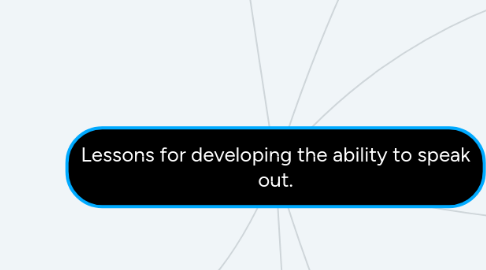
1. Speech purposes.
1.1. Communication
1.1.1. to inform
1.1.2. to notify
1.1.3. to retell
1.1.4. to tell
1.2. Explanation
1.2.1. to characterize
1.2.2. to clarify
1.2.3. to emphasize
1.2.4. to describe
1.3. Approval
1.3.1. to recommend
1.3.2. to suggest
1.3.3. to acquit
1.3.4. to thank
1.4. Reprobation
1.4.1. to refute
1.4.2. to deny
1.4.3. to challenge
1.4.4. to shame
1.5. Conviction
1.5.1. to induce
1.5.2. to persuade
1.5.3. to inspire
1.5.4. to assure
2. Retelling
2.1. The retelling is justified communicatively.
2.1.1. to retell what student saw
2.1.2. to retell what student heard
2.1.3. to retell what student saw and heard
2.1.4. to retell what student read
2.2. The retelling is methodically justified.
2.2.1. to retell what student read
2.2.1.1. This type is the most popular and controversial.
2.2.1.2. A waste of time in the classroom.
2.2.1.3. The benefits of this exercise are small.
2.2.1.4. This exercise does not characterize the student as a person.
2.2.1.5. Training speech.
2.3. Learning to retell in a different way.
2.3.1. to retell to people who are not familiar with the content of what the student read
2.3.2. to retell with a specific speech purpose
2.3.3. to retell with the situation in mind and a large context
2.4. Necessary conditions for the lesson.
2.4.1. The teacher should not ask students to read and retell the same text.
2.4.2. The teacher should only offer texts that are interesting to students.
2.4.3. The teacher should start teaching retelling with spoken texts.
2.4.4. The teacher should move from the textual transmission of the content of the narration.
2.5. Retelling in your own words.
2.5.1. It is interesting as an exercise.
2.5.2. It has great potential.
2.5.3. It has a number of varieties.
2.5.4. It requires certain conditions to be met.
2.5.5. It involves a transition.
2.5.6. When the student wants to convey something new and interesting from the text.
2.5.7. When the student wants to express their attitude to the perceived.
2.5.8. When the student wants to specifically influence the addressee in a certain direction.
2.5.9. If the student can understand the meaning of the source text even if there are unfamiliar words.
2.5.10. If the student is able to distinguish the main and secondary in the content of the text.
2.5.11. If the student has a sufficient stock of lexical units.
2.5.12. If the student knows the basic forms of the grammatical system of a foreign language so well that he is able to use the necessary synonymous constructions.
2.5.13. If the student is able to transform and combine the language forms of the source text.
2.6. Retelling in your own words is the right way to speech skills.
2.6.1. to highlight the main thing
2.6.1.1. to shorten
2.6.1.1.1. to replace with synonyms
3. Statements
3.1. Dialogue
3.2. Monologue
3.2.1. Characteristic qualities of the monologue.
3.2.1.1. Expediency
3.2.1.2. Logicality
3.2.1.3. Structure
3.2.1.4. Completeness
3.2.1.5. Productivity
3.2.1.6. Continuity
3.2.1.7. Independence
3.2.1.8. Expressiveness
4. Speech exercises
4.1. provides a speech strategy and tactics
4.2. actualizes the relationship of participants in communication
4.3. develops speech activity and independence
4.4. provides verbal and structural diversity
5. Two types of speech-based purposes.
5.1. Deterministic
5.1.1. set a purpose - a strategic line according to which students build their statements
5.2. Nondeterministic
5.2.1. determine the direction in which students need to speak out, independently determining the strategic line of utterance
6. To prepare a set of speech exercises for the lesson, the teacher must:
6.1. 1. determine the purpose for which the complex is being built
6.2. 2. determine the necessary speech tasks that will contribute to the development of this quality, and their quantitative ratios
6.3. 3. determine the sequence and ratio of exercises according to the stages of skill development
6.4. 4. distribute the supports according to the stages and conditions of training
7. Supports for the development of speech skills.
7.1. Content supports
7.1.1. Verbal
7.1.1.1. Visual and auditive
7.1.1.1.1. texts, stories, letters, pictures and photos
7.2. Semantic supports
7.2.1. set a specific idea or thought that needs to be expressed
7.2.1.1. sayings, quotes, popular expression
